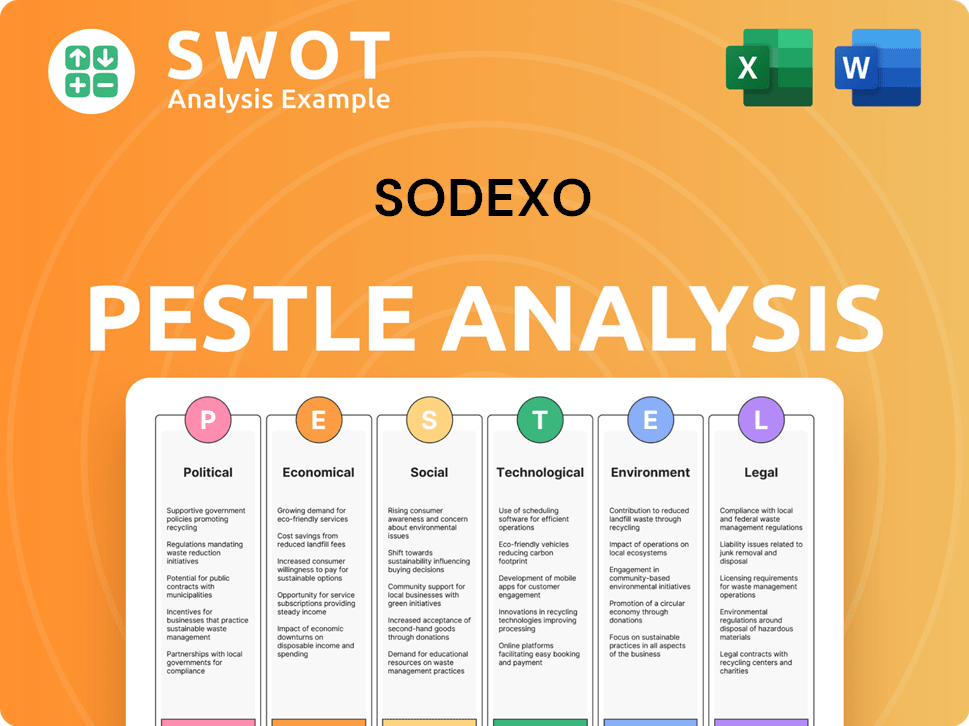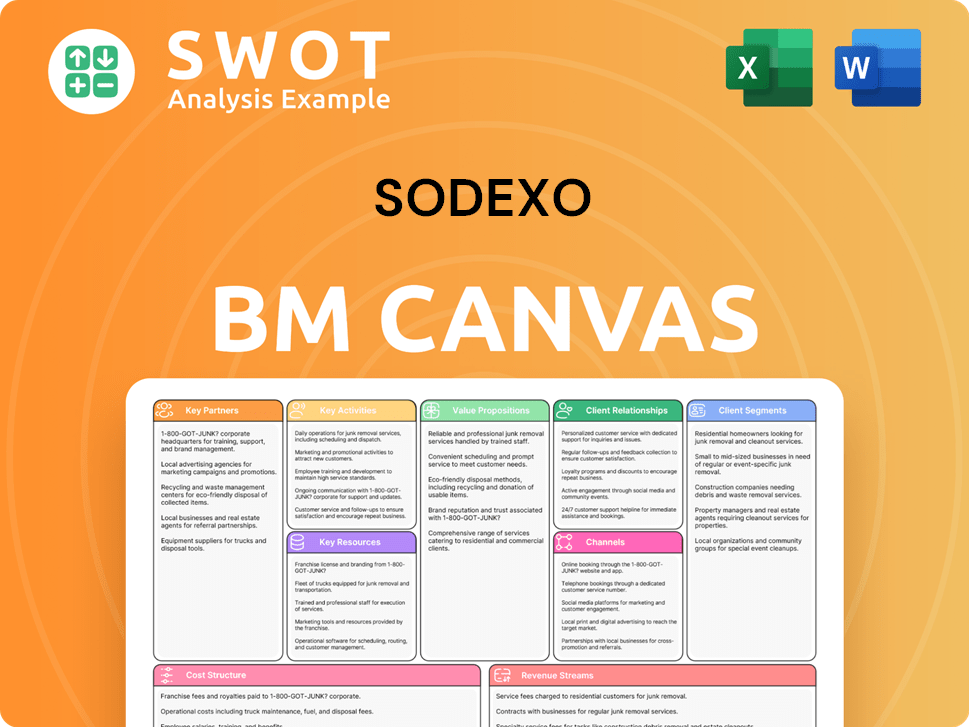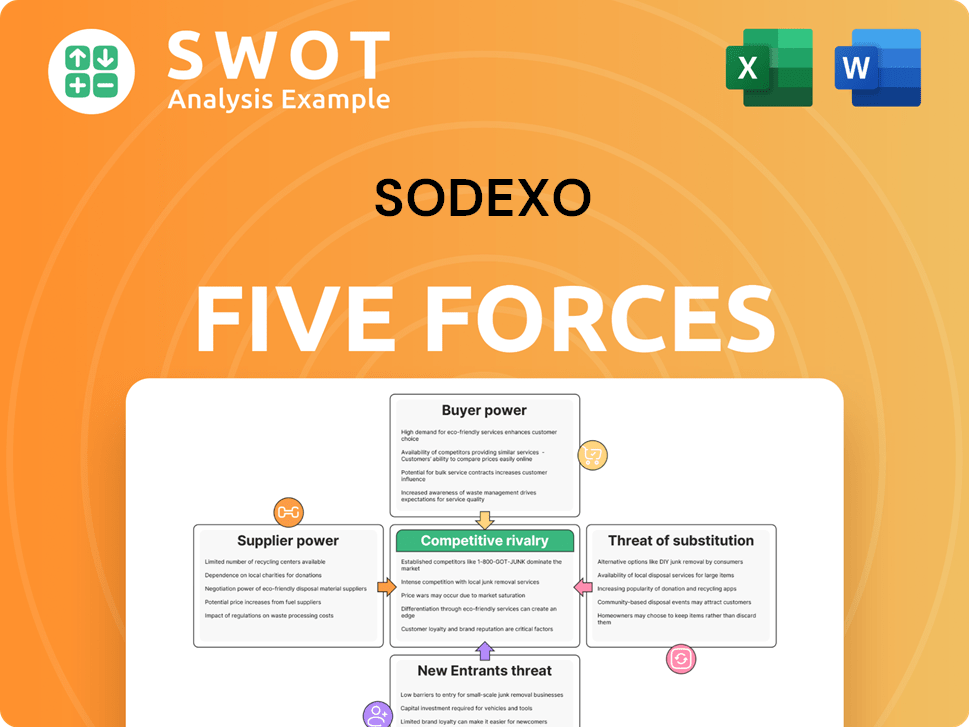Sodexo Bundle
Can Sodexo's Strategic Pivot Fuel Future Growth?
Sodexo, a titan in food services and facilities management, is undergoing a significant transformation with the spin-off of its Benefits & Rewards Services division, now known as Pluxee. This strategic move, finalized in early 2024, signals a renewed focus on its core On-site Services. This shift begs the question: how will Sodexo leverage this restructuring to enhance its Sodexo SWOT Analysis and drive future growth?

This article delves into the Sodexo growth strategy, examining its Sodexo business model and exploring the Sodexo future prospects in a rapidly evolving market. We will conduct a comprehensive Sodexo company analysis, evaluating its Sodexo financial performance, Sodexo market share, and the impact of factors like inflation and competition. Furthermore, we'll explore Sodexo expansion plans in North America and its Sodexo sustainable growth initiatives, providing actionable insights for investors and stakeholders alike.
How Is Sodexo Expanding Its Reach?
The primary focus of the company's expansion strategy is on organic growth within its On-site Services segment. This is complemented by strategic mergers and acquisitions to broaden its market reach and service offerings. The company aims to leverage its strong market position in North America and Europe while also pursuing growth opportunities in emerging markets, which is a key aspect of the overall Sodexo growth strategy.
A significant part of the expansion involves increasing its integrated facilities management (IFM) offerings. This moves beyond traditional catering to include a wider array of services such as cleaning, maintenance, and security. This approach aims to deepen client relationships, increase contract values, and diversify revenue streams. The company's Sodexo business model is evolving to meet changing client needs.
The spin-off of Pluxee is expected to provide greater financial flexibility, allowing for investments in core On-site Services. This will drive both geographical and service-line expansion. The company is also exploring new business models, such as hybrid work solutions and personalized consumer experiences, to adapt to evolving market trends. This proactive approach is vital for the company's Sodexo future prospects.
The company is actively expanding its presence in emerging markets, focusing on regions with high growth potential. This includes strengthening its foothold in countries where demand for its services is increasing. Expansion efforts are supported by strategic partnerships and acquisitions to accelerate market entry and enhance service capabilities. This approach is part of the company's Sodexo geographic expansion strategies.
The company is diversifying its service offerings beyond traditional catering and facilities management. This includes expanding into areas such as healthcare, education, and corporate services. The goal is to provide a comprehensive suite of services that meet the evolving needs of clients. This diversification strategy is crucial for long-term growth and is a key aspect of the Sodexo sustainable growth initiatives.
A key focus is on expanding its IFM offerings, which involves providing a broader range of services. This includes cleaning, maintenance, and security, aiming to deepen client relationships and increase contract values. The expansion of IFM services is a core element of the company's growth strategy. This is a critical component for the Sodexo innovation in facilities management.
The company is investing in digital transformation to improve operational efficiency and enhance client experiences. This includes implementing new technologies and digital tools across its service lines. Digital initiatives are aimed at streamlining processes, improving service delivery, and gaining a competitive edge. This is a part of the Sodexo digital transformation strategy.
The company is actively pursuing strategic partnerships and alliances to enhance its market position. These collaborations help to expand service offerings and enter new markets more effectively. Partnerships are crucial for leveraging expertise and resources, driving innovation, and increasing market share. These partnerships are vital for Sodexo strategic partnerships and alliances.
- Partnerships with technology providers to improve service delivery.
- Alliances with local businesses to expand into new geographic areas.
- Collaborations with industry leaders to enhance service offerings.
- Joint ventures to enter specialized market segments.
Sodexo SWOT Analysis
- Complete SWOT Breakdown
- Fully Customizable
- Editable in Excel & Word
- Professional Formatting
- Investor-Ready Format

How Does Sodexo Invest in Innovation?
The innovation and technology strategy of the company is crucial for its sustained growth, focusing on enhancing operational efficiency, improving client satisfaction, and creating new value propositions. This approach involves significant investments in research and development to integrate digital solutions across its service offerings. The company leverages data analytics and artificial intelligence (AI) to optimize service delivery, personalize consumer experiences, and improve resource allocation.
A key aspect of the digital transformation involves using data analytics and AI to streamline operations and enhance customer experiences. This includes AI-powered tools for menu planning that cater to diverse dietary needs and preferences, and IoT sensors for real-time monitoring of facility performance. Sustainability initiatives are also deeply embedded in their innovation strategy, with efforts focused on reducing food waste, promoting sustainable sourcing, and implementing energy-efficient solutions in facilities management.
Partnerships with technology startups and external innovators are also key to their approach, allowing the company to rapidly adopt cutting-edge solutions and maintain its competitive edge in a rapidly evolving market. The company's commitment to innovation is evident in its strategic investments and collaborations, ensuring it remains at the forefront of industry advancements. For a deeper understanding of the company's customer focus, consider exploring the Target Market of Sodexo.
The company is actively implementing digital solutions across its service offerings. This includes smart kitchens, automated inventory management, and predictive maintenance in facilities management. Data analytics and AI are used to optimize service delivery and personalize consumer experiences.
AI-powered tools are used for menu planning to cater to diverse dietary needs. IoT sensors are deployed for real-time monitoring of facility performance. These technologies enhance efficiency and improve service quality.
The company focuses on reducing food waste, promoting sustainable sourcing, and implementing energy-efficient solutions. Sustainability is a core component of their innovation strategy. These efforts align with broader environmental goals.
The company collaborates with technology startups and external innovators. These partnerships enable the rapid adoption of cutting-edge solutions. This approach helps maintain a competitive edge in the market.
The company invests in research and development to drive innovation. This investment supports the integration of digital solutions. R&D is crucial for long-term growth and market leadership.
The company aims to enhance operational efficiency through technological advancements. Automation and data-driven insights streamline processes. This leads to cost savings and improved service delivery.
The company's innovation strategy encompasses various technological advancements aimed at improving service delivery and operational efficiency. These initiatives are designed to enhance client satisfaction and create new value propositions. Key areas of focus include:
- Smart Kitchens and Automated Inventory Management: Implementing advanced kitchen technologies to optimize food preparation and reduce waste. Automated systems streamline inventory tracking and management.
- AI-Powered Menu Planning: Utilizing AI to create customized menus that cater to diverse dietary needs and preferences. This enhances customer satisfaction and reduces food waste.
- IoT Sensors for Facility Performance: Deploying IoT sensors to monitor facility performance in real-time. This enables predictive maintenance and improves resource allocation.
- Data Analytics and Predictive Maintenance: Leveraging data analytics to predict equipment failures and schedule maintenance proactively. This reduces downtime and improves operational efficiency.
- Digital Platforms for Client Engagement: Developing digital platforms to enhance client engagement and provide personalized services. These platforms improve communication and streamline service delivery.
Sodexo PESTLE Analysis
- Covers All 6 PESTLE Categories
- No Research Needed – Save Hours of Work
- Built by Experts, Trusted by Consultants
- Instant Download, Ready to Use
- 100% Editable, Fully Customizable

What Is Sodexo’s Growth Forecast?
The financial outlook for Sodexo, particularly after the Pluxee spin-off, indicates a strategic shift towards a more focused business model. This restructuring aims to enhance profitability and drive growth within its core On-site Services segment. The company's recent performance and future projections highlight its commitment to sustainable growth and market leadership.
For the first half of fiscal year 2024, Sodexo demonstrated strong financial performance. Revenues reached 12.1 billion euros, reflecting an organic growth of +8.5%. This growth was fueled by solid activity across all segments and geographies, with notable contributions from North America and Europe. This positive trend underscores the effectiveness of Sodexo's business strategies and its ability to adapt to market dynamics.
Sodexo's strategic focus includes improving operational efficiency and cost management. The company is targeting an underlying operating profit margin of approximately 5.5% for fiscal year 2024. This financial discipline, combined with a strong balance sheet and disciplined capital allocation, supports the company's strategic plans for expansion. The company's growth strategy is further detailed in this Brief History of Sodexo.
Sodexo projects an organic revenue growth of +6% to +8% for fiscal year 2024. This projection demonstrates confidence in the company’s core business trajectory. This continued growth is expected to be driven by strategic initiatives and operational efficiencies.
The company's net profit for the first half of fiscal year 2024 was 475 million euros. This represents a significant increase compared to the previous year. This increase reflects improved operational performance and strategic financial management.
Sodexo plans further investment in its core On-site Services. This investment aims to drive both organic expansion and potential targeted acquisitions. These moves are designed to bolster its market leadership and enhance its service offerings.
Sodexo's growth strategy includes focused geographic expansion strategies. The company is particularly focused on North America and Europe. These regions are key drivers of revenue and profit growth.
The company's financial performance and strategic initiatives position it well for future growth. Sodexo's focus on its core business, combined with disciplined financial management, is expected to drive long-term value creation. The company's ability to adapt to changing market conditions and capitalize on opportunities is critical to its continued success.
Sodexo Business Model Canvas
- Complete 9-Block Business Model Canvas
- Effortlessly Communicate Your Business Strategy
- Investor-Ready BMC Format
- 100% Editable and Customizable
- Clear and Structured Layout

What Risks Could Slow Sodexo’s Growth?
The path of Sodexo's growth strategy and its future prospects is not without its challenges. Several potential risks and obstacles could impact the company's ability to achieve its goals. Understanding these challenges is crucial for a comprehensive Sodexo company analysis.
Intense market competition, regulatory changes, and supply chain vulnerabilities present significant hurdles. The need for continuous innovation and adaptation to technological advancements further complicates the landscape. Moreover, managing a vast global workforce and ensuring consistent service quality across diverse contexts pose internal challenges.
Sodexo's success hinges on its ability to navigate these risks effectively. The company's risk management framework, including scenario planning and diversification, is key. Adapting to evolving client demands and market dynamics will be essential for sustainable growth.
The food services and facilities management sectors are highly competitive. Numerous global and regional players constantly vie for contracts. Sodexo faces ongoing pricing pressures and the need to innovate service offerings to stay ahead of rivals.
Changes in regulations, particularly in food safety, labor laws, and environmental standards, can impact operational costs. Sodexo must continuously adapt to these changes, which can be costly and time-consuming. Compliance is a critical aspect of its operations.
Supply chain disruptions, as seen in recent global events, pose risks to consistent service delivery and cost management. Sodexo needs robust supplier diversification and risk mitigation strategies to address these vulnerabilities. These are crucial for maintaining operational efficiency.
Technological advancements present both opportunities and risks. Sodexo must keep pace with these advancements and effectively integrate new technologies into its operations. Failure to do so could impact its competitiveness. Digital transformation is key.
Managing a vast global workforce and ensuring consistent service quality across diverse cultural and operational contexts can be challenging. Sodexo must focus on employee training and development to maintain high service standards. This is crucial for customer satisfaction.
Economic downturns and inflationary pressures can affect Sodexo's financial performance. Rising labor costs and the price of raw materials can squeeze profit margins. Strategic pricing and cost management are essential to mitigate these impacts.
Sodexo employs a comprehensive risk management framework. This includes scenario planning to anticipate potential challenges. Diversification of its client portfolio and service offerings helps spread risk. Continuous investment in employee training and development is also a key strategy.
The ability to adapt to evolving client demands and market dynamics is crucial. Sodexo must remain flexible and responsive to changes in the business environment. This includes embracing technological advancements and adjusting to new regulations. The company's agility will determine its long-term success.
For a deeper understanding of Sodexo's business model and revenue streams, consider reading this article: Revenue Streams & Business Model of Sodexo. This provides valuable insights into the company's operations and financial structure.
Sodexo Porter's Five Forces Analysis
- Covers All 5 Competitive Forces in Detail
- Structured for Consultants, Students, and Founders
- 100% Editable in Microsoft Word & Excel
- Instant Digital Download – Use Immediately
- Compatible with Mac & PC – Fully Unlocked

Related Blogs
- What are Mission Vision & Core Values of Sodexo Company?
- What is Competitive Landscape of Sodexo Company?
- How Does Sodexo Company Work?
- What is Sales and Marketing Strategy of Sodexo Company?
- What is Brief History of Sodexo Company?
- Who Owns Sodexo Company?
- What is Customer Demographics and Target Market of Sodexo Company?
Disclaimer
All information, articles, and product details provided on this website are for general informational and educational purposes only. We do not claim any ownership over, nor do we intend to infringe upon, any trademarks, copyrights, logos, brand names, or other intellectual property mentioned or depicted on this site. Such intellectual property remains the property of its respective owners, and any references here are made solely for identification or informational purposes, without implying any affiliation, endorsement, or partnership.
We make no representations or warranties, express or implied, regarding the accuracy, completeness, or suitability of any content or products presented. Nothing on this website should be construed as legal, tax, investment, financial, medical, or other professional advice. In addition, no part of this site—including articles or product references—constitutes a solicitation, recommendation, endorsement, advertisement, or offer to buy or sell any securities, franchises, or other financial instruments, particularly in jurisdictions where such activity would be unlawful.
All content is of a general nature and may not address the specific circumstances of any individual or entity. It is not a substitute for professional advice or services. Any actions you take based on the information provided here are strictly at your own risk. You accept full responsibility for any decisions or outcomes arising from your use of this website and agree to release us from any liability in connection with your use of, or reliance upon, the content or products found herein.